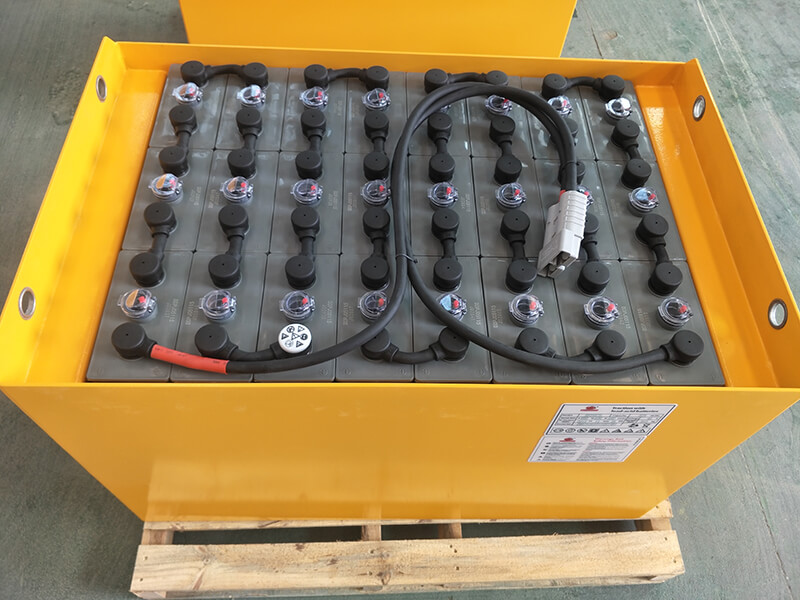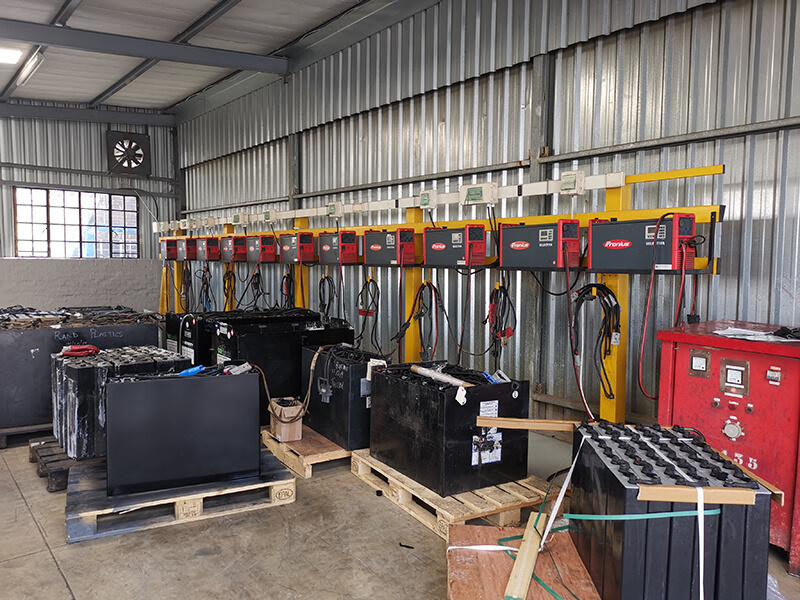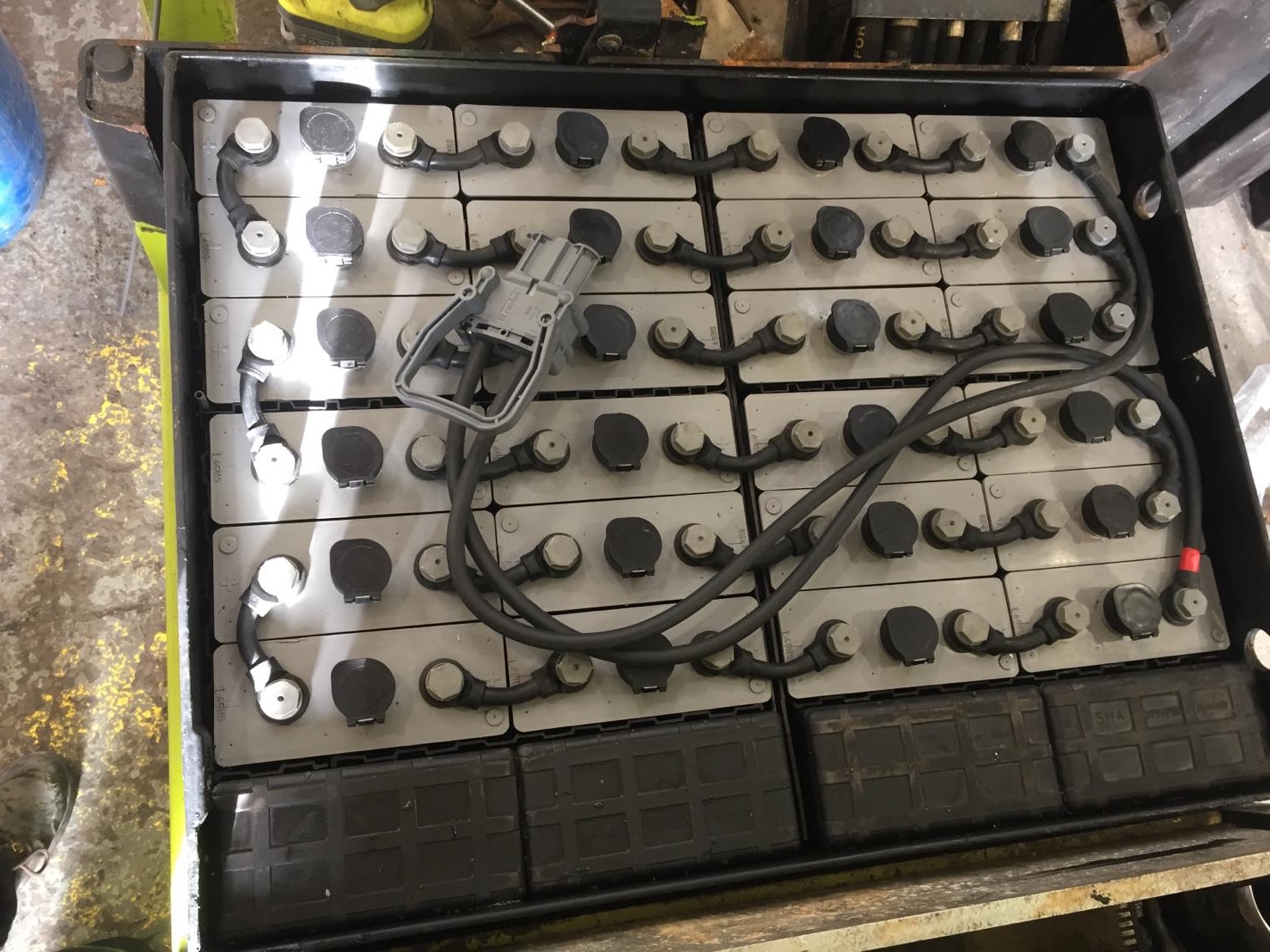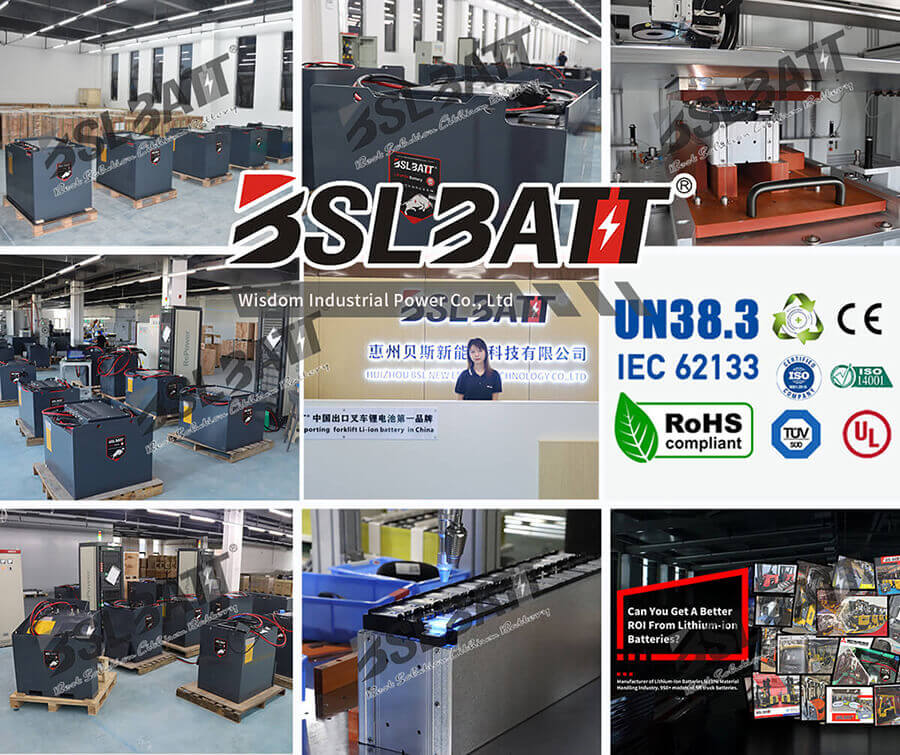|
Wisdom Power is the best source for forklift Batteries, industrial batteries, Lift Truck Batteries, Walk Behind Batteries, Scissor Lift Batteries, Sweeper Batteries, Scrubber Batteries, Golf Carts Batteries, and other industrial equipment batteries.
Electric lift trucks made up 84 percent of the U.S. forklift market last year; by now, it’s likely that some (or all) of your fleet runs on lead-acid battery power.
An industrial forklift battery is typically comprised of the following components:
Battery case. The battery case houses the battery’s individual cells. The number of cells can range from six to 36, depending on the voltage. Voltage is usually 12, 24, 36 or 48 volts.
Battery cells. The battery cells are essentially small, self-contained individual batteries made up of a series of tightly-stacked lead plates filled with sulfuric acid.
Battery bars. The battery bars are large lead bars that link the individual cells, creating a complete circuit.
Battery cables. These cables can vary in size from 4-gauge wire, which is roughly the diameter of a pencil, all the way up to 4/0 cable that can be more than an inch in diameter. Stout wiring is required in order to handle the high amperage some batteries can generate. Some batteries can have an amp hour rating of as much as 1,200 amps. A typical arc welder needs only 250-300 amps to melt and weld thick steel. You can see why large cables are critical to the operation.

Lead-acid forklift batteries provide a voltage between two output terminals with a series of electrochemical reactions. Here’s how the process works:
Three substances interact within the cell of a lead-acid forklift battery:
● Plates of lead dioxide.
● Plates of pure, soft lead called “spongy lead.”
● An electrolyte mixture of sulfuric acid and water.
Each battery cell contains layers of lead dioxide and spongy lead in alternating plates. When the acidic electrolyte comes into contact with these compounds, complex chemical reactions create an imbalance of electrons between the two types of plates. Electrons will naturally flow from the negative plate toward the positive plate, attempting to correct the imbalance of subatomic particles.
The lead dioxide plates all connect to a single positive terminal while the plates of spongy lead attach to a negative terminal; these terminals create an external circuit. If we connect the terminals to a conductor — say, a forklift’s power system — electrons will move from terminal to terminal through the conductor. That’s how we harness the voltage generated by the battery’s chemical reactions.
Forklift battery chargers reverse the process with a steady flow of voltage. The energy from the charger converts leads sulfate back into its original forms of lead, increasing the specific gravity of the sulfuric acid present in the electrolyte. This prepares the battery to restart the discharge process. It’s less like filling a gas tank and more like evaporating and condensing the same glass of water again and again.
When you’re used to seeing electric forklifts zip around a facility every day, it’s easy to take their power source for granted. However, the lead-acid forklift battery is worth considering in some detail. It’s a fascinating technology, and understanding the basic science behind forklift batteries will help you implement effective battery maintenance programs and improve the efficiency of your entire fleet.
What does a forklift battery cost?
Forklift batteries cost between $2,000 and $6,000 depending on specs and size. When selecting a battery, be sure to answer the following questions:
What is the vehicle voltage or a number of cells in the battery?
Does the truck require an EE or EX-battery?
What is the compartment size of the truck?
Is the truck compartment covered or does the battery require a cover?
What kind of charging connector is used on the truck?
What position on the battery do you wish the battery cables to come off the tray?
Can I buy a used forklift battery?
Used forklift batteries usually cost around $1,500 to $3,500. You can buy used industrial batteries through a local material handling or battery dealer. Used batteries go through rigorous testing and maintenance before being sold. This ensures the battery works at maximum capacity by being cleaned, equalized and filled with fresh acid.

What is a forklift battery charger?
The industrial charger is responsible for charging the forklift battery as quickly as possible without shortening the battery’s lifespan due to overheating and overcharging. Before the advent of the current generation of forklift battery chargers, the operator was responsible for setting the desired voltage and amperage for charging the battery, thus opening the door for human error and damage. Today’s industrial charger contains a complex network of cards and sensors that effectively remove the human from the equation. Today, chargers have preset parameters that protect the battery from overcharging and damage. These preset parameters will actually stop charging and display error codes if there is a problem with the battery instead of pumping the battery full of power until it either boils over or in a worst-case scenario, catches fire.
There are myriad choices as for industrial chargers from small portable chargers that plug into any wall socket, to large wall mounted units that require large amperage capacities with dedicated wiring. Current chargers allow the user to custom-tune a specific charge cycle. This customization allows you to control everything from the amount of voltage, amperage, charging time, and even the fill rate over a given time span. These controls allow you greater flexibility in charging, as well as longer battery life and performance.
Modern industrial chargers might contain the following components:
The charger case, which houses all of the internal components of the charger.
Circuit cards, large capacitors, and very large transformers sometimes weighing 100 pounds each. Sometimes, as many as four transformers can be found in some chargers and diodes. These transformers are responsible for transforming AC electricity into DC electricity.
A digital display shows the operator the vital statistics of the battery, the selected charge cycle, and its status.
The charger cable, and heavy gauge cables, which transfer the high amp loads and voltage to the battery.
What does a forklift battery charger cost?
Forklift battery chargers range in cost from $500 for a portable charger that will plug into a standard 120-volt AC outlet, up to about $3,000 for a charger that must be wired into to the building’s electrical system by a licensed electrician. The price varies depending on the specifics of the charger.
Can I buy a used forklift battery charger?
Used forklift battery chargers are available, and are generally priced about 40-60 percent less than a new forklift battery charger.
Can I rent a forklift battery and charger?
Forklift batteries and chargers are available to rent together or separately. Prices depend on battery weight, battery specifications, and desired charger specs. When renting a forklift battery, see ” What does a forklift battery charger cost?” earlier in this article.
When renting, or purchasing, a forklift battery charger, ask the following questions:
What is the voltage of the battery that you want to charge? The voltage of your battery must match the charger voltage.
What phase of electricity (1 PHS or 3 PHS)?
What is the battery AH (amp hours) rating?
What is the line voltage at the location at which the forklift battery charger will be used? The charger and line voltage must match.
Will the battery charger be stored in a freezer or cold storage?
Batteries should not be charged below 32 degrees Fahrenheit.
What is battery monitoring?
Battery monitoring is the act of monitoring an industrial battery. This can include monitoring water levels, amp-hours, temperatures, electrolytes, and voltage imbalances. There are two main ways to monitor a forklift battery.
Battery Monitoring Devices. It is important to note that the way batteries are charged and discharged affects your warehouse productivity. Batteries need to be charged and discharged properly in order to maintain their full available capacity. Improperly discharged batteries can lead to more battery replacements and the battery will not be able to run at full performance.
Raymond Handling Concepts Corporation offers a battery monitoring device called battery. This device is attached to the truck and provides the following information for the operator:
● Battery temperature, water levels, charge intervals and state of charge
● Low water levels
● Battery temperature conditions, weight, and overcharges
● Maintenance alerts
● Undersized battery alerts
The information gathered by battery can be viewed on your computer, tablet or smartphone. Some of the benefits of using battery monitoring include decreased cost of ownership, optimized efficiency, increased productivity and assurance with warranty requirements.
Battery Water Monitors. This is a device that monitors the battery’s water level (also known as its electrolyte) and alerts the operator to know when the battery needs water. An LED light is placed on top of the battery and will blink green when electrolyte levels are okay and blink red when the battery needs water. LED light colors can differ, but these are their usual colors.
If batteries are watered too frequently, an electrolyte boil-over can occur. This reduces battery capacity by 3 percent each time electrolytes spillover. If batteries are watered infrequently, permanent damage can be done to both the lift truck and battery. Battery water monitors can eliminate scheduled weekly inspections since the monitor simply alerts the operator when the battery needs water.

Proper battery care and watering can help extend the life of your industrial battery. These seven simple tips will make sure your forklifts are always powered:
● Seven tips for proper battery maintenance
● Keep the battery clean, dry, and free from corrosion
● Maintain the correct water level (about one-half inch below the battery cap opening)
● Add water only after the charge cycle
● Set up a weekly or bi-monthly watering schedule to ensure proper water levels
● Avoid opportunity charging (charging during break times and lunch breaks) because each time you connect the battery to a charger, it uses one of its life cycles
● Inspect your battery for any defects or malfunctions, and have your service provider repair them as needed
● Have your batteries washed and serviced semi-annually to help control acid and corrosion.
10 commandments of battery care
● Add approved water only— never add acid
● Keep electrolyte level above separator protectors
● Keep battery top clean and dry
● Keep flames and metal away from the battery top
● Keep vent caps tightly in place
● Discharge to no lower than 80 percent, and do not operate battery if the specific gravity is below 1.150 for Powerline, Varta, Waterless, and
● Top Power batteries, and 1.175 for Energy-Plus batteries
● Cool before charging or operating if the battery is above 115 degrees Fahrenheit
● Only use approved chargers of correct voltage and current output
● Keep truck compartment and battery cover open during charging
● When in doubt, call your service representative for assistance
Watering instructions:
● Approved water: Only distilled and deionized water should be added to batteries, be sure to check your manual for specifications.
● Proper electrolyte level: The electrolyte level must be kept between the “high watering level” and the separator protectors. Only fill batteries at the end of the charging cycle.
Call Today and we will deliver the exact 48-volt battery you need! 48 Volt Forklift Battery - Call Today +86-0752-2819-469!
We have been supplying forklift batteries for over 36 years and have the experience to send the right battery every time!
At the same time, we have another brand, BSLBATT, which focuses on forklift lithium batteries. BSLBATT is one of the largest developers, manufacturers, and integrators of lithium-ion batteries for lift trucks in China. BSLBATT supports and guides our distributors to be NO. 1 in the Replacement of Lead Acid Batteries with LiFePO4 Forklift Batteries in the local market. The company sells large quantities of industrial batteries for various equipment. It successfully collaborates with several OEM market leaders. Visit our link to read more: https://www.lithiumforkliftbattery.com/forklift-batteries.html

We would love to hear from you today!
|

















